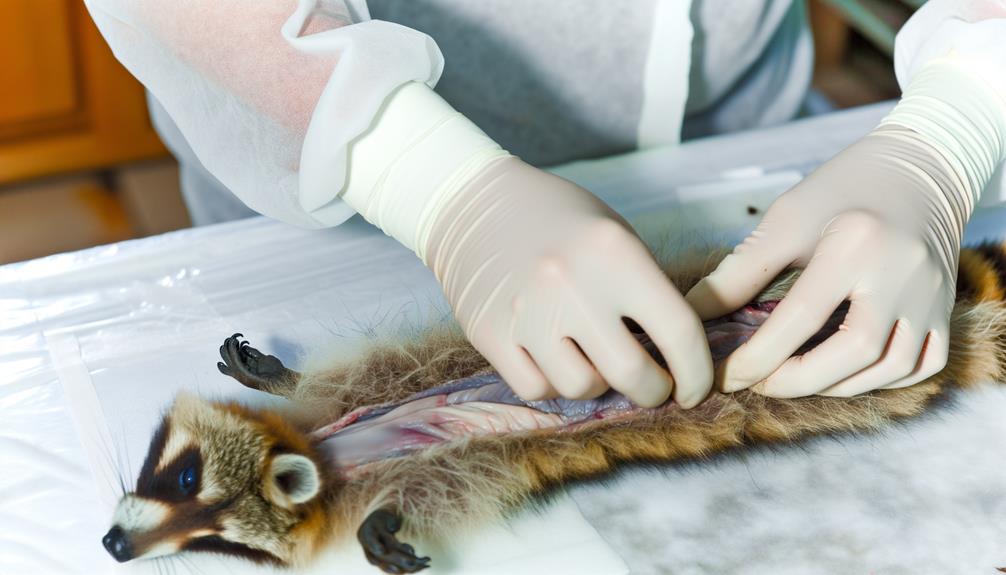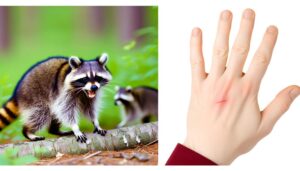Skinning a Raccoon and How You Get Rabies Risks
Skinning a raccoon poses a risk of rabies transmission if there is contact with the animal's nervous tissue or saliva. Rabies thrives in the central nervous system, and exposure to infected brain or spinal tissue can facilitate viral entry.
Protective measures, such as wearing gloves and protective clothing, are critical for reducing this risk. Immediate and thorough cleaning of any wounds, followed by post-exposure prophylaxis, is essential if exposure occurs.
Recognizing early symptoms and seeking prompt medical consultation is necessary for effective intervention. For detailed insights into rabies prevention and management, continue to gain an in-depth understanding.

Key Takeaways
- Rabies can be transmitted through direct contact with the raccoon's nervous tissue during skinning.
- Exposure to saliva when skinning a raccoon increases the risk of contracting rabies.
- Aerosol transmission of rabies is possible in enclosed spaces while skinning raccoons.
- Using personal protective equipment significantly reduces the risk of rabies transmission.
- Immediate wound cleaning and medical consultation are crucial after potential exposure to rabies while skinning a raccoon.
Understanding Rabies
Rabies is a viral zoonotic disease caused by the Lyssavirus genus, primarily transmitted through the saliva of infected animals. This neurotropic virus attacks the central nervous system, leading to encephalitis and, if untreated, is almost invariably fatal. Clinical manifestations include prodromal symptoms such as fever, malaise, and pain at the exposure site, followed by neurological symptoms like agitation, hydrophobia, and paralysis.
Diagnostic confirmation involves direct fluorescent antibody testing, PCR, and viral isolation techniques. Immunoprophylaxis via pre- and post-exposure vaccination remains the cornerstone of rabies prevention. Given the high case-fatality rate, healthcare providers must maintain a high index of suspicion and initiate timely prophylactic measures to mitigate risks associated with potential exposure, particularly in high-risk activities such as skinning wildlife.
How Rabies Spreads
Transmission of the Lyssavirus occurs mainly through the bite wounds, scratches, or mucosal exposure to the saliva of an infected animal, facilitating the ingress of the virus into the host's peripheral nervous system. This mode of transmission is critical, as the virus travels centripetally toward the central nervous system, eventually leading to encephalitis.
Evidence indicates that the virus can also spread through aerosolized particles in specific environments, such as caves inhabited by rabid bats, though such instances are exceedingly rare. Human-to-human transmission is virtually non-existent, largely limited to corneal or organ transplants from an infected donor.
Understanding these pathways is essential for implementing effective preventive measures and ensuring public health safety when dealing with potential rabies exposures.
Risks of Skinning Raccoons
Engaging in the process of skinning raccoons poses significant risks due to potential exposure to rabies virus present in the animal's nervous tissue and saliva. This exposure can occur through several pathways, elevating the danger to individuals involved.
- Contact with Nervous Tissue: Direct contact with the raccoon's brain or spinal cord can transmit the virus, especially if there are cuts or abrasions on the handler's skin.
- Saliva Contamination: Rabid raccoons may have contaminated their fur with saliva, posing a risk if the handler touches their face or mouth during the skinning process.
- Aerosol Transmission: In rare instances, the virus can be inhaled if aerosolized nervous tissue particles are present, particularly in enclosed spaces.
Addressing these risks is paramount for ensuring the safety of those involved.
Protective Measures
To lessen the risks associated with skinning raccoons, employing thorough protective measures is vital. Utilizing personal protective equipment (PPE) reduces the likelihood of exposure to rabies. Evidence-based guidelines recommend the use of gloves, protective eyewear, and impermeable clothing to create effective barriers against potential viral transmission. Additionally, proper handling and disposal techniques of carcasses and tools are essential. The following table outlines key protective measures:
| Protective Measure | Description | Importance |
|---|---|---|
| Gloves | Use thick, impermeable gloves | Prevents direct contact |
| Protective Eyewear | Wear goggles or face shields | Shields eyes from exposure |
| Impermeable Clothing | Wear long sleeves and pants | Minimizes skin contact |
| Proper Disposal Practices | Follow biohazard disposal protocols | Ensures safe removal |
Implementing these measures guarantees safety for those handling raccoons, maintaining public health standards.
Symptoms of Rabies
The clinical presentation of rabies progresses through distinct stages.
Beginning with nonspecific early warning signs such as fever, headache, and general malaise.
This is followed by the onset of neurological symptoms, including agitation, hyperactivity, and hydrophobia.
In advanced stages, patients may experience paralysis, coma, and ultimately, death if untreated.
Early Warning Signs
Initial symptoms of rabies often resemble those of common viral infections, including fever, headache, and general malaise. These early signs can be nonspecific and misleading, complicating timely diagnosis. However, recognizing these initial indicators is important for early intervention. Clinicians should be vigilant for the following early warning signs:
- Fever: Often low-grade, appearing within days of exposure.
- Headache: Persistent and increasing in severity.
- General malaise: A sense of discomfort or unease, preceding more severe symptoms.
These early manifestations, though subtle, necessitate prompt medical attention, especially following potential exposure to rabies through activities such as skinning wildlife. Early detection and post-exposure prophylaxis (PEP) are essential in preventing the progression to the fatal stages of rabies.
Neurological Symptoms
Progression of rabies leads to the onset of neurological symptoms, which are indicative of viral invasion into the central nervous system. Clinically, patients may exhibit a range of symptoms including agitation, confusion, and hallucinations, reflecting encephalitic involvement.
This is often accompanied by autonomic dysfunction such as hyper salivation and hydrophobia. The virus disrupts normal neural function, resulting in paresthesia, paralysis, or muscle spasms. Behavioral changes become evident, with potential aggression or hyperactivity, further complicating the clinical picture.
Diagnosis during this phase necessitates prompt intervention, given the highly fatal nature of rabies once neurological symptoms become apparent. Understanding these manifestations is vital for healthcare providers to initiate timely and appropriate management, thereby improving patient outcomes in this critical stage.
Advanced Rabies Stages
As rabies progresses into its advanced stages, patients experience severe encephalitic or paralytic manifestations that signify extensive viral dissemination within the central nervous system. These advanced symptoms are both dire and distressing, necessitating immediate medical intervention to alleviate suffering.
- Hydrophobia and Aerophobia: Patients exhibit profound fear of water and drafts of air, leading to painful spasms.
- Neurological Deterioration: Severe agitation, confusion, hallucinations, and seizures become prominent, reflecting extensive brain inflammation.
- Autonomic Dysfunction: Irregular heart rhythms, excessive salivation, and respiratory difficulties emerge, indicating widespread autonomic nervous system involvement.
Clinicians must recognize these symptoms promptly to offer palliative care, as the disease at this stage is typically fatal. Understanding these manifestations is critical for those dedicated to alleviating human suffering and ensuring compassionate care.
Steps After Exposure
Upon potential rabies exposure, immediate and thorough wound cleaning with soap and water is critical to reduce viral load at the entry site. Following this, prompt medical consultation is essential to evaluate the need for rabies post-exposure prophylaxis (PEP).
PEP, consisting of rabies immunoglobulin and a series of rabies vaccinations, is highly effective if administered timely.
Immediate Wound Cleaning
Immediate wound cleaning is a critical step in rabies post-exposure prophylaxis, necessitating thorough irrigation and cleansing of the affected area with soap and water to reduce viral load. The efficacy of this initial response cannot be overstated.
Evidence-based practices recommend:
- Immediate Action: Begin cleaning the wound within minutes of exposure to minimize viral infiltration.
- Thorough Irrigation: Use copious amounts of water to flush out contaminants, ensuring mechanical removal of potential pathogens.
- Antiseptic Application: Apply an iodine solution or alcohol-based disinfectant to further reduce infection risk.
These steps are foundational in mitigating the risk of rabies transmission, essential for those dedicated to ensuring the highest standards of care and safety.
Medical Consultation Necessity
Following thorough wound cleaning, seeking immediate medical consultation is vital to assess the need for post-exposure prophylaxis and further management.
Early evaluation by a healthcare professional guarantees accurate risk assessment based on the exposure type, wound characteristics, and local epidemiology of rabies.
Clinicians will conduct a detailed history and physical examination to determine if rabies virus exposure has occurred. Laboratory tests may be ordered to rule out secondary infections.
Timely intervention is essential as rabies is nearly always fatal once clinical symptoms appear. Adherence to evidence-based guidelines for post-exposure management reduces the risk of rabies transmission.
Consultation with infectious disease specialists may be needed for complex cases to ensure thorough care and best possible outcomes.
Post-Exposure Prophylaxis
Administering post-exposure prophylaxis (PEP) promptly is crucial to prevent the onset of rabies after potential exposure.
PEP involves a series of steps that must be followed to ensure effective prophylaxis:
- Wound Cleansing: Immediate and thorough washing of the wound with soap and water for at least 15 minutes to reduce viral load.
- Rabies Immune Globulin (RIG): Administered to provide immediate passive immunity, ideally infiltrated around the wound site.
- Rabies Vaccination: A series of four doses of rabies vaccine administered intramuscularly on days 0, 3, 7, and 14.
Timeliness is paramount; delay in initiating PEP markedly increases the risk of rabies infection, a disease with nearly 100% fatality once clinical symptoms appear.
Conclusion
Understanding the potential risks associated with skinning raccoons is paramount, given the severe implications of rabies—a disease historically known for its fatal consequences, reminiscent of the tragic fate of Old Yeller.
Rabies transmission primarily occurs through bites, yet exposure to nervous tissue during skinning poses a significant risk. Adhering to stringent protective measures and immediate medical intervention post-exposure can mitigate the threat, reinforcing the critical importance of vigilance in handling wildlife.






